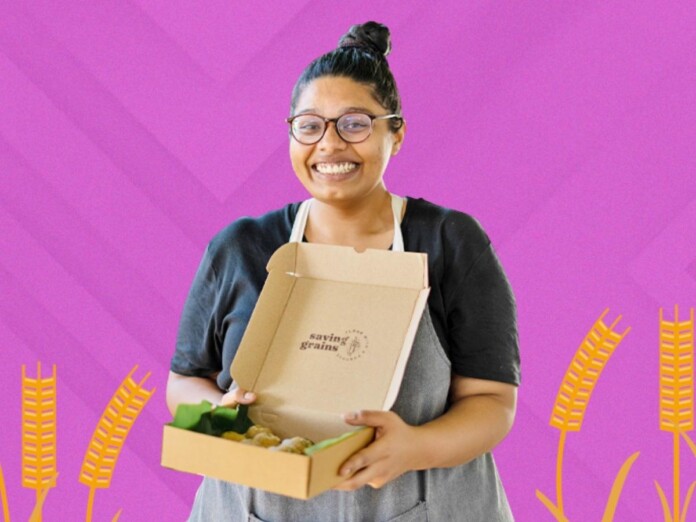In a world where sustainability is the buzzword of the hour, food waste doesn’t take the center stage. Imagine this – that inviting, malty aroma that fills the air during a brewery tour, those grains that play a vital role in crafting your favorite brew, have a journey of their own after they’ve served their brewing purpose.
Globally, it’s become a trend to transform those spent grains into various goodies – granola, brownies, cookies. But here in Bangalore, with nearly 60 microbreweries that could produce around 12000 kgs of brewers spent grains per day, we asked ourselves, how do we make this “non-traditional and sustainable” food source our own?
We’ve taken the road less travelled, forging a path to turn brewers’ spent grain (BSG) into delightful laddoos. And let me tell you, these aren’t your everyday laddoos; they’re a blend of tradition and sustainability.
But why laddoos, you ask? Well, why not? They encapsulate the heart of culture – a symbol of love and celebration. And what better way to celebrate than by upcycling a product that makes up a whopping 85% of brewing waste? That’s right, BSG has been hiding in plain sight as a sustainable powerhouse.
So, what does it taste like? “Just like homemade laddoos” – we blend the brewers spent grain with our favorite ingredients like besan, rava, coconut, ginger to get the right balance.
But it’s not just about the taste. It’s about the bigger picture. Food waste contributes to a staggering 15% of global carbon emissions, and BSG is a significant contributor to this issue. By upcycling BSG into laddoos, we’re taking a huge step in reducing food waste and its environmental impact. We’re turning a traditionally non-traditional food source into a sustainable urban food system in Bangalore.
In the process, we’re not just making laddoos; we’re making a statement. We’re declaring our commitment to a greener, more sustainable world. We’re encouraging you to indulge in tradition and sustainability, one laddoo at a time.
Protein Rich
BSG is the by-product of the beer brewing process. While the usual nomenclature is “spent” grain, in reality, the grain is considered a rich source of fibre, protein, and phenolic compounds. Research studies and investigation into products that are being made from this grain across the world show that although the grain is “spent” of a lot of its starch and sugars, it still has good protein and fibre content and is potentially a great food for humans and pets and has great value as a material that can stay in use!
The spent grain we’ve sourced and tested here in Bangalore, has about 23% protein and 46% dietary fibre. It also has less than 0.1% gluten. This makes it favourable for senior citizens, diabetics and those with digestive issues.
And what we love best about the grain is its flavour. Adding it to bread, chapati, cookies – surprises the eater with great malty and earthy flavours – thanks to the malted barley based and the mashing process.
Saving Grains’ Journey
Our vision for Saving Grains is to create a scalable circular model in this food economy that is accountable, transparent, collaborative and puts people at the heart of the project.
In 2019, there were approximately 200 microbreweries in India and 67 in Bangalore alone. A typical microbrewery produces around 8,000 liters of beer every month and there are over 200 microbreweries in India today. This results in approximately 320 tons of spent grain every month. One can only imagine what that figure would look like in 2030!
But Saving Grains is not just about upcycling and creating a product alone. It’s about people and the community. Relationships between brewers and bakers (and their community) have been around since the beginning of time. (which came first, beer or bread!).
What is the potential of those relationships in today’s times? What would they look like in Bangalore’s pub city? How could these relationships help strengthen the community, not just by looking into spent grain as an affordable and nutritious food source, but by engaging people every step of the way and creating spaces and opportunities to increase their incomes, build community, improve their livelihoods, and create an atmosphere for responsible food citizenship?
The idea for this potential model comes from research into how food spaces can nurture food citizenship through the circular economy. Often when we think about the circular economy in food, keeping resources in use is a priority. But what if we put the world’s largest resource – human beings – in the centre of this economy.
Can we use food (spent grain) as a tool to add value to so-called “waste” by working closely with natural systems and technology to empower people and communities around us for now and certainly in the future?
Collaborative Model
At Saving Grains, we’re currently processing small batch spent grain flour – we call it “Good Flour” because it’s delicious and has all that nutrition. We are also building a value added product range featuring granola, biscuits, cookies, pasta, chapati’s and seasonal treats, like this years laddoo, halwa chikki drop.
The idea is to build a collaborative model to upcycle spent grain. This means everyone who participates in the process of saving these grains is involved.
We currently work with Geist Brewing Co. They are a zero liquid discharge brewery in Bangalore and have a great vision regarding sustainability. They also work with the spent grain flour and have it on their menu.
We work with a community centre called Kutumba where we’ve started using this flour to make chapati’s – our daily bread! This centre is focused on women empowerment and community development.
And we work with home bakers, and professional bakers to develop recipes and make some good bread and good treats like brownies! The grain/flour is also being used to make non-edible materials. Isn’t that interesting?












